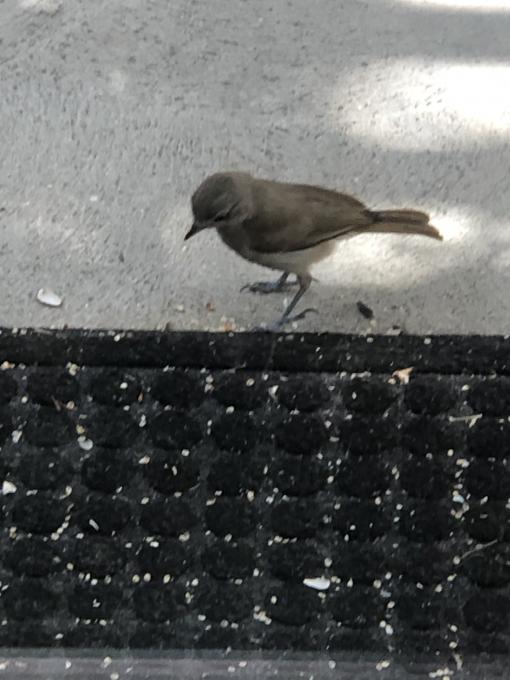Laurie
Forum Replies Created
Viewing 5 posts - 1 through 5 (of 5 total)
-
LaurieParticipantActivity 1: We have a charming little Oak Titmouse in our yard and one day we saw him pecking on our Wisteria. We did a bit of research and found out that Oak Titmice do peck on wood however, they have an uneven tap while our Acorn Woodpecker have a specific rhythm they stick to. Activity 2: We noticed that our House Finches eat almost all of our seed in one day, but the Oak Titmouse will drop by, take a seed, and leave. The White-breasted Nuthatch does not take any seeds and we just see a blur of white and black. Activity 3: We have learned to identify the song of the Spotted Towhee which is three beats and a trill.


 in reply to: Activities: Noticing Behaviors #728091
in reply to: Activities: Noticing Behaviors #728091 -
LaurieParticipant
@Sophia Me too!!!
in reply to: Activities: Different Seasons, Different Birds #717552 -
LaurieParticipantActivity 1--We noticed that the migration patters sometimes were the same directions, but on different sided of the country. It was interesting to watch the movement and the increases and decreases in the population of certain areas. Activity 2 -- We looked at migration patterns of the birds we have identified so far. Most of the birds are with us year round, such as the Spotted Towhee, Red-Tailed Hawk, and Oak Titmouse. The one we found that is not with us all year us is the White-crowned Sparrow. We saw this bird all winter, but it disappeared when the weather changed. Since we are inexperienced birders, it was a validating experience when we saw that our observations were confirmed by reliable data. Using the migration patters will be very beneficial as we begin to identify more and more birds. Activity 3 --We noticed that the male American Goldfinch, in the summer, has a pastel yellow body, an orange bill, and a black cap. By winter, the bird had a brown body, a brown bill, and the black cap had disappeared. The Common Loon, in the summer, had a black-green head, white spots and stripes all over the body, a black bill, and a dark blue chest band. By winter, the body of the bird was brown, the bill was grey, there were no spots or chest band, and the chest was white. Activity 4--Because of Covid-19, our favorite birding spot is our back yard. In our yard we have House Finches, Oak Titmice, Spotted Towhees, California Towhees, Mourning Doves, Black Phoebes, and Bewick's Wren. All of these birds stay is Santa Clarita year round, but in the winter we have White-Crowned Sparrows, so in six months we can expect that. My granddaughter and I are taking this course together. I am homeschooling her, and we incorporating this class into her science. We have learned so much throughout this course and are turning into avid birdwatchers. Birds just used to be feathers and sounds. It is very empowering to know the names of our local birds, learn their habits, and recognize some of their songs (song ID is difficult). Looking forward to being able to expand our birdwatching range soon. Our spotted Towhee:
 in reply to: Activities: Different Seasons, Different Birds #717551
in reply to: Activities: Different Seasons, Different Birds #717551 -
LaurieParticipantActivity #1: We went for a walk yesterday and we saw, the Red Tailed Hawk, the Black Phoebe, Bewick's Wren, Northern Mockingbird, a Mourning Dove, and we heard: and Spotted Towhee, and a California Scrub Jay. Activity#2: We have seen many of the birds that were "most likely", but we will try to spot the Dark-Eyed Junco. Activity#3: The birds we did not know about are, the Violet-Green Swallow, the American Kestrel, Costa's Hummingbird, the Mountain Chickadee, and the Peregrine Falcon.
 in reply to: Activities: Local Bird Exploration #714533
in reply to: Activities: Local Bird Exploration #714533 -
LaurieParticipantFor activity #1, I decided on the California Scrub Jay and the Black Phoebe. I could tell them apart because the Scrub Jay had a long body and a thick, long bill, and the Phoebe had a small body and short bill. For activity #2 I chose the House Finch, Acorn Woodpecker, and the Spotted Towhee. The House Finch has red on its breast, and sometimes on its head. The Acorn Woodpecker has red on its cap, and the Spotted Towhee has red on its wings. The Spotted Towhee's coloring is more orange than red, but I will still include it in my list. For activity #3 I chose the Oak Titmouse, the Mourning Dove, and the Common Raven. The Oak Titmouse will peck at wood with an uneven tapping, the Mourning Dove will peck at the ground for food, and the Common Raven will hunt for food. For activity #4 I chose the Oak Titmouse. The Oak Titmouse pecks for food on tree branches, is small and has a brownish-gray crest, and is brown, gray, and white. These tools have helped me so much on my birding journey and I notice them more and more every time I see a bird. Thank you for this course!in reply to: Activities: Bird ID Practice #706561
Viewing 5 posts - 1 through 5 (of 5 total)




